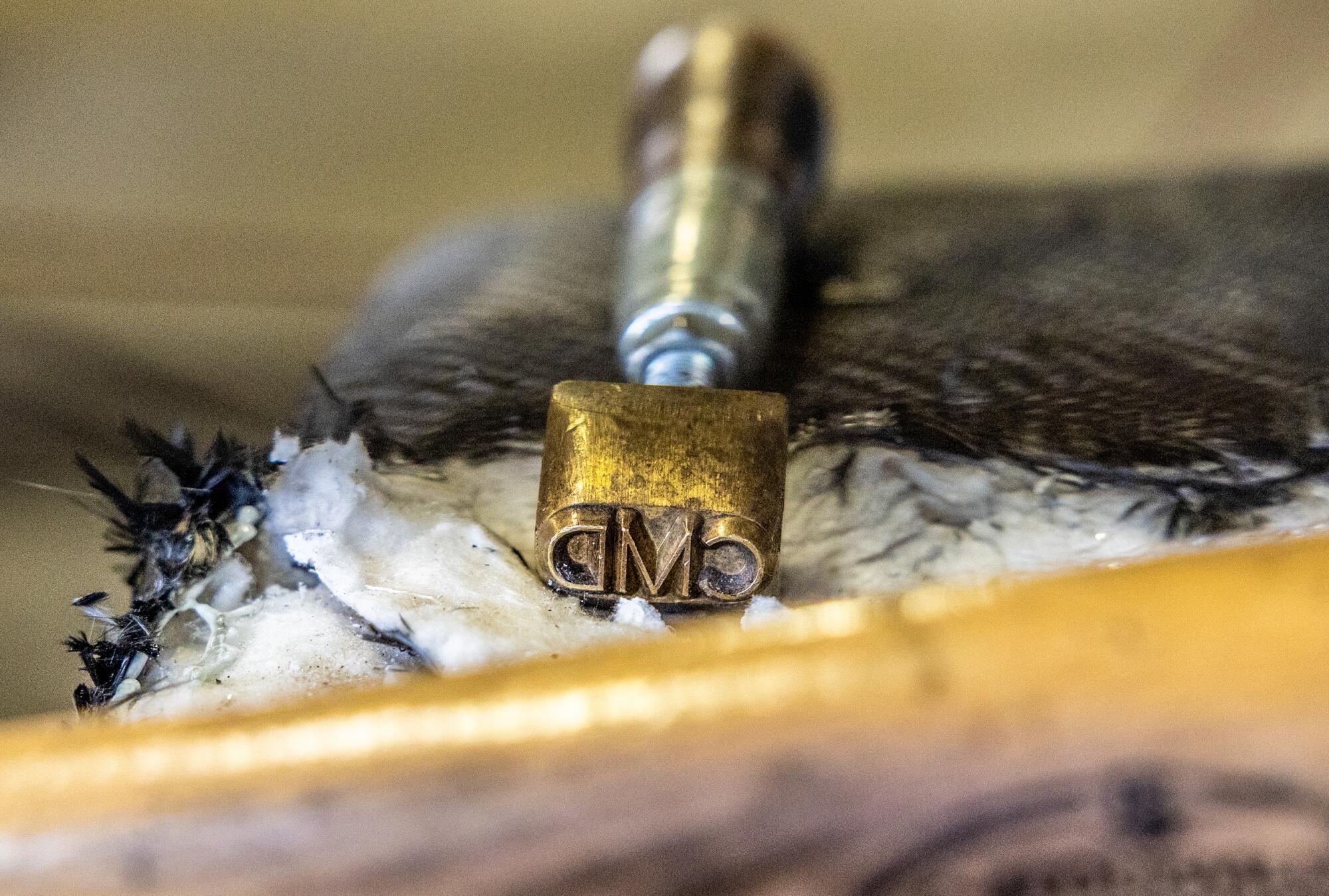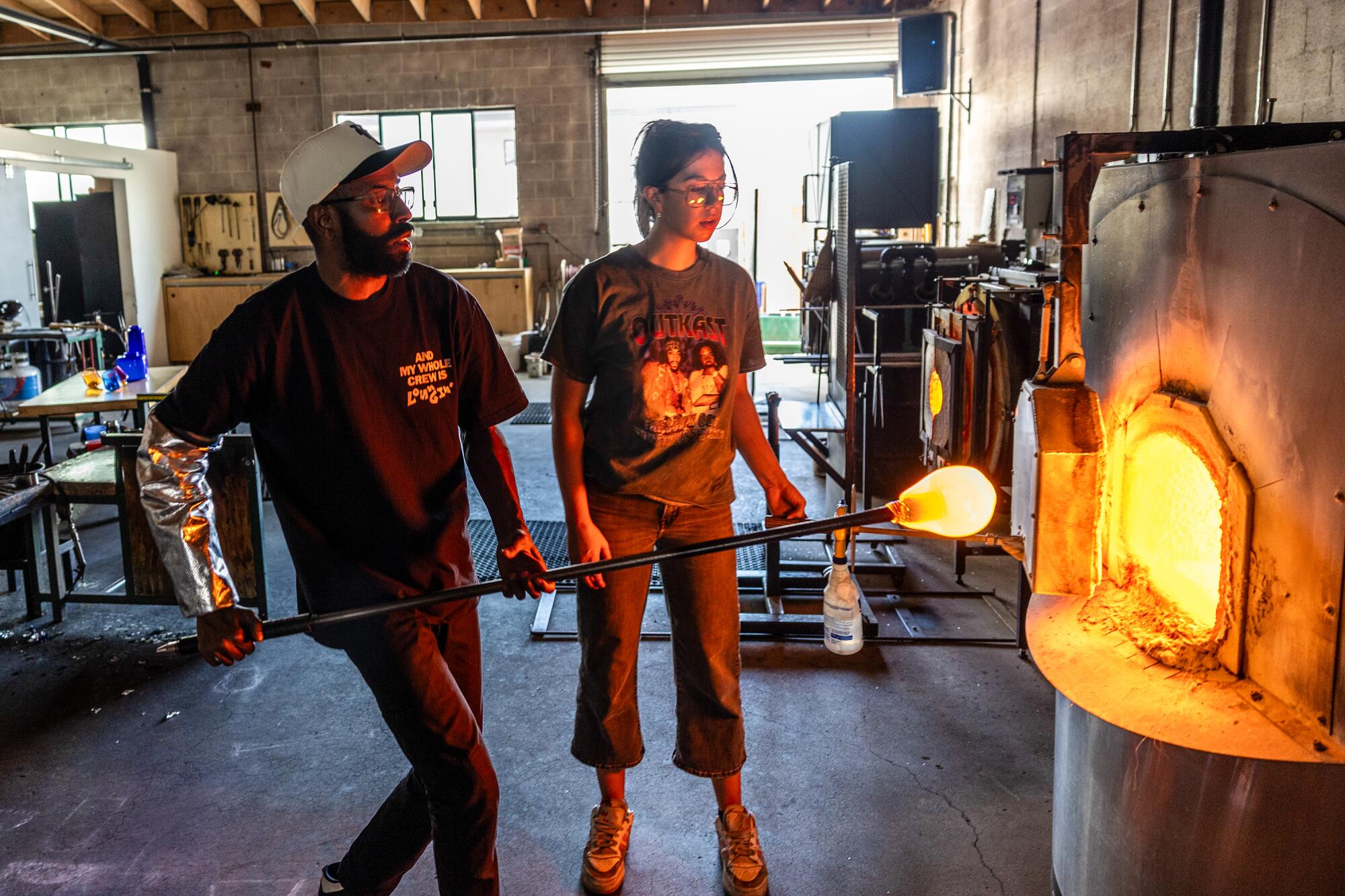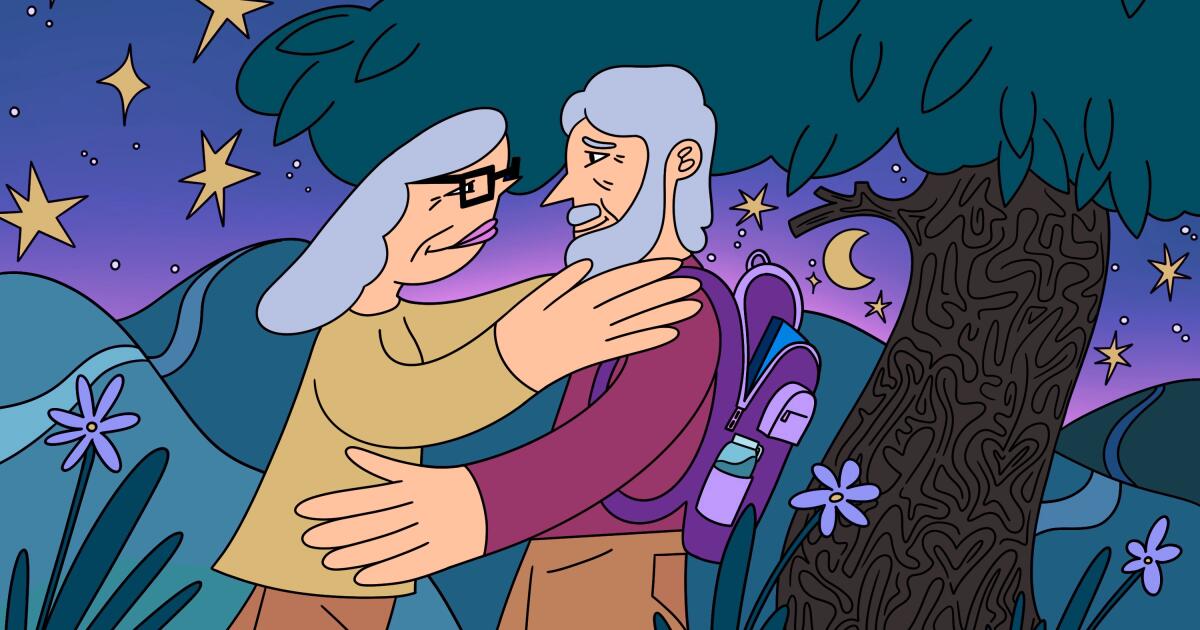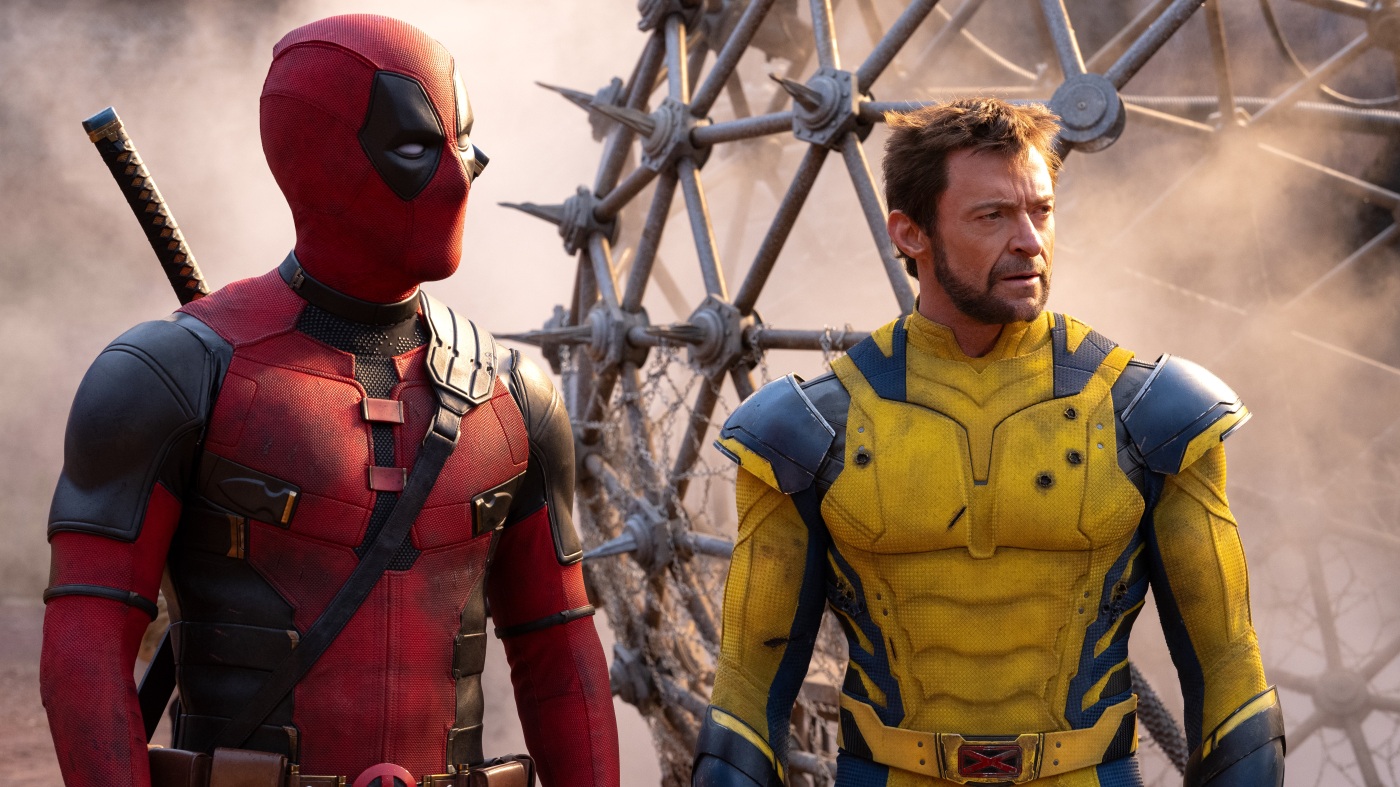Lifestyle
His 'funk is contagious.' This L.A. glassblower breaks the rules with his stunning vessels

Seated on a chair, with the hum of twin furnaces and the Impressions playing in the background, glassblower Cedric Mitchell is lost in his craft as he and assistant Sara Roller turn and sculpt molten glass with steel shears.
After a few blasts of a blow torch and several trips back and forth to the furnace, the red-hot glass on the rod turns cobalt blue and forms what will eventually become a 7-inch vase.
Color is the first thing you notice about the artist’s hand-blown glass vessels.
“I love color,” Mitchell says, “which is weird because I wear black every day.”
Mitchell, 37, was an emerging hip-hop artist in Tulsa, Okla., when he first considered glassblowing. It was 2012, and he was recording a song in a Tulsa music studio when he noticed his friend’s impressive glass bong.
“He told me about a studio in downtown Tulsa where I could take a glass-blowing class as an elective at my community college,” says Mitchell, who was studying business at Tulsa Community College. “I immediately signed up for the class at 1 a.m.”
Colorful glass totems by glass artist Cedric Mitchell in his El Segundo studio.
(Robert Gauthier / Los Angeles Times)
Inspired by his friend’s bong, Mitchell had his heart set on making glass pipes.
But when he showed up for the first day of class at the Tulsa Glassblowing School, the instructor calmly explained that it was a nonprofit and that “we would not be making bongs,” Mitchell adds wryly.
Six months later, Mitchell was teaching glassblowing at the studio as an intern in exchange for practice time.
He stuck with it because it was difficult. “Glassblowing is one of the hardest things I’ve ever done,” Mitchell says. “It’s the most rewarding and also the most discouraging. Sometimes impostor syndrome sets in, and I wonder, ‘Am I even good at this?’ You must stay within the process instead of thinking of the outcome.”
When asked what inspires him, Mitchell’s list is endless: “I like graffiti, music, three-dimensional art, digital compositions that I see on Pinterest, furniture, Frank Lloyd Wright architecture, James Turrell sculptures. I also like a lot of fashion in bright colors. I used to be fashionable until I started blowing glass, and then I muted my color palette.”
Mitchell grew up in North Tulsa, a predominantly Black neighborhood where more than 35% of the population lives in poverty. When his mother remarried, his family moved to the South Side, where he attended what he describes as “a rich white school.” It was an experience that taught him how to “maneuver in both worlds.”
“I don’t know how I would have turned out if I had stayed in North Tulsa,” he says quietly. He remembers falling in love with music during his senior year of high school when he first heard Kanye West. “My English teacher told me I would be a great orator because I liked writing poetry and read a lot of Shakespeare,” Mitchell says. “She’s the one who tried to convince me to go to college, but I wanted to learn how to produce music like Kanye. When I learned how hard that would be, I studied business basics in community college.”
While famous glass artists such as Dale Chihuly and Rui Sasaki flocked to art schools like the Rhode Island School of Design, Mitchell’s path was uniquely his own. “I learned by working as an apprentice in the studio,” he says. “I kept showing up until they paid me.”
Mitchell notes that glassblowers are rarely Black. “When I did a Google search for ‘famous Black glass artists,’ I found three,” he says. (Therman Statom, Debora Moore and Ché Rhodes). However, the scarcity of Black artists in his chosen field made him more determined to succeed. He now says his challenge was, ‘How can I stand out?’ “I wanted to break all the design rules similar to Ettore Sottsass,” he added, “and develop my own style.

Cedric Mitchell’s kinetic glassware swivels on an amber ball.
(Soona Studios)
So Mitchell set about creating irreverent objects: hand-blown kinetic glassware that swivels on a ball, colorful stacked geometric shapes he calls totems and tall textured bottles with whimsical patterns.
The key, he says, was practice. “Robert Greene’s book ‘Mastery’ really helped me,” Mitchell says. “The main thing for me was improving my skill set through practice. I still embody that today: the perpetual practice of things.”
Mitchell’s bold style — something he calls “modern funk” — is informed by Sottsass’ playful Memphis-Milano Design Group of the 1980s, which blended bold geometric shapes with the primary colors of Pop Art.
By 2015, Mitchell was ready to leave Tulsa and devote himself full-time to his art.
He was still working at the Tulsa studio when he struck up a friendship with Los Angeles glassblower Joe Cariati. “I commented on one of his YouTube videos, and we became friends,” Mitchell says of his mentor. “Joe invited me to L.A. to a demo they were doing. I was sending my resume to studios, and everyone wanted me to do interviews. When I asked Joe what to do, he offered me a job.”
Mitchell moved to Los Angeles, which he calls a “healthy melting pot of creatives,” with only his bike and two suitcases. Upon arrival, he rode his bike to El Segundo from Culver City to get to work at 7 a.m. as Cariati’s assistant.
The COVID-19 pandemic, however, is what “lit the fire under me,” he says. Worried that he could not continue working while everyone was staying home amid pandemic-related closures, Mitchell took advantage of a 30-day free trial and created a Shopify account for solo makers to showcase his work.
His efforts were worthwhile. The account caught the eye of longtime California design studio Heath Ceramics. “We were taken by his postmodern-like shapes and juxtaposition of bold colors,” says Heath co-owner Cathy Bailey. After crafting pieces in line with Heath’s seasonal collections for some time, Mitchell created a stand-alone showcase that blended vibrant, geometric pieces and traditional patterns. “Our best partnerships are when we both inspire and push each other in unexpected ways; working with Cedric is one of those,” says Bailey.

Mitchell’s initials, set into a stamp he uses to sign his artwork.

Assistant glassblower Sara Roller looks on as Cedric Mitchell removes molten glass from a furnace in his El Segundo studio.
Mitchell agrees. “Heath was one of the best things that happened to me,” he says as he stamps the bottom of a vase for Heath’s summer seasonal collection. “They gave me the opportunity to get better.”
Los Angeles lighting designer Brendan Ravenhill, who is working with Mitchell on a new fixture debuting in June, says: “Cedric’s funk is contagious” when it comes to craftsmanship. “We always look for people based in Southern California who are the best at what they do,” Ravenhill adds. Mitchell has the skills to produce and refine the difficult shape, he says.
Like the owners of so many small businesses in Los Angeles, Mitchell admits that 2023 was a tough year.
“It’s hard to do production in L.A. because nothing here is cheap. Natural gas prices and the cost of the studio rental are going up. Last year, I had to fly to Seattle to finish my order for Heath because the natural gas price rose 300%. I couldn’t even afford to blow glass here.”
Still, he acknowledges that many good things happened in a year of firsts: He had his first big residency at the Corning Museum of Glass in New York, allowing him to explore his craft without financial constraints. He also got married, welcomed a son and attended his first trade show in New York.

The Tulsa native says that when he googled “famous Black glassblowers,” he found only three.
(Robert Gauthier / Los Angeles Times)
Currently, Mitchell spends his days at his glassblowing workshop in El Segundo, creating drinkware, vases, decorative bottles and lighting. In addition to teaching, he has done brand alignment photo shoots with Nike, Fitbit and Elder Statesmen and is working with fellow glassblower and painter Corey Pemberton on Better Together, an event series designed to support Black and brown makers.
“Cedric is one of the most dedicated, hard-working artists I know,” says Pemberton, executive director of Crafting the Future, a nonprofit designed to introduce artists of color to the medium, residencies and entrepreneurship programs. “He fits more into a day than the average person would think possible. He can handle anything you throw at him and will do so with an incredibly calm demeanor.”
Beyond his work prowess, he’s a dedicated friend. “He is the type of friend you could call on for anything, and he’ll pull up, no questions asked,” Pemberton adds.
As someone who did not grow up exposed to art and glassblowing, Mitchell hopes to inspire a new generation of artists by rejuvenating the visual arts after-school program at the Watts Labor Community Action Community.
“No one is telling kids in underserved communities that they can be creators or makers,” Mitchell says of his proposal, which is pending approval. “We live in an entrepreneurial revolution, and people can be their own bosses and control the narrative of what they want to do. It’s scary, but it can be more risky working for someone. When you have ownership of something, you control the narrative. It’s like taking the stairs instead of the elevator, but it’s yours.”

Cedric Mitchell turns what will eventually be a 7-inch vase in his El Segundo studio.
(Robert Gauthier / Los Angeles Times)

Lifestyle
'Wait Wait' for July 27, 2024: With Not My Job guest Kathleen Hanna

Kathleen Hanna of The Julie Ruin performs onstage at the 2016 Panorama NYC Festival – Day 2 at Randall’s Island on July 23, 2016 in New York City. (Photo by Nicholas Hunt/Getty Images)
Nicholas Hunt/Getty Images/Getty Images North America
hide caption
toggle caption
Nicholas Hunt/Getty Images/Getty Images North America
This week’s show was recorded in Chicago with host Peter Sagal, judge and scorekeeper Bill Kurtis, Not My Job guest Kathleen Hanna and panelists Meredith Scardino, Peter Grosz, and Mo Rocca Click the audio link above to hear the whole show.
Who’s Bill This Time
Momala Takes Over; Assigned Seats Are Back; And The Heat Is On
The Olympic Torch Reporch
Our Summer Olympics Preview
Bluff The Listener
Our panelists tell three stories about someone committing an office faux pas, only one of which is true.
Not My Job: We quiz Bikini Kill’s Kathleen Hanna on Hanna-Barbera
Punk icon Kathleen Hanna plays our game called, “Kathleen Hanna Meet Hannah-Barbera.” Three questions about the animation studio.
Panel Questions
Hide Your Receipts; VR Meets ER; Avocado Apologies
Limericks
Bill Kurtis reads three news-related limericks: Situation Room Cocktails; Burrito Bird; Hopped Up Sharks
Lightning Fill In The Blank
All the news we couldn’t fit anywhere else
Predictions
Our panelists predict what will be the big story out of the Paris Olympic Games
Lifestyle
L.A. Affairs: At 77, I had a crush on my best friend’s widower. Did he feel the same way?

At 77, I had given up. After two failed marriages and years of unsuccessful dating, I accepted what seemed to be my fate: single for almost 40 years and single for however many remained. You don’t get it all, I told myself. I was grateful for family, friends and work. Life settled into what felt like order.
Until Ty.
As the husband of my best friend, he was no stranger, but he was usually peripheral. Then 10 years ago, my friend got lung cancer. I watched during visits, stunned at how nurturing Ty could be, taking care of her even though they had separated years before at her request.
After she died, Ty and I stayed in touch sporadically: a surprise sharing of his second granddaughter a year after we scattered my friend’s ashes, an invitation to the launch of my book a year later. Ty attended, hovering in the back, emerging after everyone left to attentively help load my car.
Two more years passed. During quiet moments, I remembered his sweetness. I also remembered his handsome face and long, tall body. Confused about what I wanted, I texted Ty, who’s an architect, under the guise of purchasing a tree for my backyard.
We spent an afternoon at the nursery, laughing, comparing options and agreeing on a final selection. When the tree arrived, I emailed a photo. He emailed a thank you.
Another three years passed, broken only by news of his third granddaughter and my memories of how good it felt to be with him. Alert to his attentiveness, but unsettled by both his remove and my growing interest, I risked reaching out again, this time about remodeling my garage.
Ty spent several hours at my house making measurements, checking the foundation and sharing pictures of his home in Topanga. His sketches for the garage arrived two weeks later via email.
I was grateful for his help but unsure over what sort of friendship we were developing, at least from his point of view. I, however, was clear. I wanted him to wrap his long arms around me, tell me sweet things and make me his.
Instead, I sent a gift card to a Topanga restaurant to thank him for his drawings.
“Maybe we should spend it together,” he texted.
We dined in the dusk of late summer. Our talk was easy. Discomfort lay in the unspoken. Anxious for clarity, I repeatedly let my hand linger near the candle flickering in the middle of our table. It remained untouched.
And that was as far as I was willing to go. I refused to be any more forward, having already compromised myself beyond my comfort level with what seemed, at least to me, embarrassingly transparent efforts to indicate my interest. Not making the first move was very important. If a man could not reach out, if he didn’t have the self-confidence to take the first step, he would not, I adamantly felt, be a good partner for me.
Two weeks later, Ty did email, suggesting an early evening hike in Tuna Canyon in Malibu. The setting was perfect. Sun sparkled off the ocean. A gentle breeze blew. We climbed uphill for sweeping coastal vistas and circled down to the shade of live oaks, touching only when he took my hand to steady me where the path was slippery. At the end of the trail, overlooking the juncture between the mountains and the sea, we stood opposite each other and talked animatedly for almost an hour, both of us reluctant to part.
Our conversation was engaging, but my inner dialogue was louder. When, I kept thinking, is this man going to suggest we continue the evening over dinner? We didn’t have to go out. We could eat at his house. It was 7 p.m., for God’s sake. Passing hikers even stopped to remark on our matching white hair and how well they thought we looked together. It was like a movie scene where the audience is yelling, “Kiss her, kiss her,” rooting for what they know is going to happen while the tension becomes almost unbearable. But bear it I did.
Each of us ate alone.
A few weeks later, at his suggestion, we were back at Tuna Canyon. This time Ty did invite me to end the evening at his house. Sitting close on his couch, but not too close, we drifted toward each other in the darkening room. His shoulder brushed mine reaching for his cup of coffee. My hip pressed his as I leaned in for my tea. Slowly, sharing wishes and hopes for our remaining years, we became shadows in the light of the moon. And in that darkness, in that illuminated space, he reached out.
This reticent man, this man who was so slow to move toward me, this sensitive man who hid himself behind layers so opaque I was unsure of his interest, released all that he had inside him.
“I wanted you,” Ty repeated again and again. “I was afraid of ruining things. You were her best friend. I didn’t want to lose your friendship.”
Our pent-up tension exploded.
Stunned and thrilled, I leaned into the space he opened.
Three years later, it is a space we continue to share: a place where neither of us has given up, a place where he wraps me in his long arms, a place we hold carefully against our diminishing days.
The author is the owner of a preschool in Venice as well as a psychotherapist, photographer and writer. Her first book, “Naked in the Woods: My Unexpected Years in a Hippie Commune,” was published in 2015. Her newest manuscript, “Bargains: A Coming of Aging Memoir Told in Tales,” is seeking a publisher. She lives in Mar Vista and can be found at margaretgrundstein.com, Instagram @margwla, Medium @margaretgrundstein and Substack @mgrundstein.
L.A. Affairs chronicles the search for romantic love in all its glorious expressions in the L.A. area, and we want to hear your true story. We pay $400 for a published essay. Email LAAffairs@latimes.com. You can find submission guidelines here. You can find past columns here.
Lifestyle
'Deadpool & Wolverine' is a self-cannibalizing slog

Ryan Reynolds stars as Deadpool and Hugh Jackman as Wolverine in an odd-couple action hero pairing.
Jay Maidment/20th Century Studios
hide caption
toggle caption
Jay Maidment/20th Century Studios
When Fox Studios released the first Deadpool movie back in 2016, it played like an irreverently funny antidote to our collective comic-book-movie fatigue. Wade Wilson, or Deadpool, was a foul-mouthed mercenary who obliterated his enemies and the fourth wall with the same gonzo energy.
Again and again, Deadpool turned to the camera and mocked the clichés of the superhero movie with such deadpan wit, you almost forgot you were watching a superhero movie. And Ryan Reynolds, Hollywood’s snarkiest leading man, might have been engineered in a lab to play this vulgar vigilante. I liked the movie well enough, though one was plenty; by the time Deadpool 2 rolled around in 2018, all that self-aware humor had started to seem awfully self-satisfied.
Now we have a third movie, Deadpool & Wolverine, which came about through some recent movie-industry machinations. When Disney bought Fox a few years ago, Deadpool, along with other mutant characters from the X-Men series, officially joined the franchise juggernaut known as the Marvel Cinematic Universe.
That puts the new movie in an almost interesting bind. It tries to poke fun at its tortured corporate parentage; one of the first things Deadpool says is “Marvel’s so stupid.” But now the movie also has to fit into the narrative parameters of the MCU. It tries to have it both ways: brand extension disguised as a satire of brand extension.

It’s also an odd-couple comedy, pairing Deadpool with the most famous of the X-Men: Logan, or Wolverine, the mutant with the unbreakable bones and the retractable metal claws, played as ever by a bulked-up Hugh Jackman.
The combo makes sense, and not just because both characters are Canadian. In earlier movies, Deadpool often made Wolverine the off-screen butt of his jokes. Both Deadpool and Wolverine are essentially immortal, their bodies capable of self-regenerating after being wounded. Both are tormented by past failures and are trying to redeem themselves. Onscreen, the two have a good, thorny chemistry, with Jackman’s brooding silences contrasting nicely with Reynolds’ mile-a-minute delivery.
I could tell you more about the story, but only at the risk of incurring the wrath of studio publicists who have asked critics not to discuss the plot or the movie’s many, many cameos. Let’s just say that the director Shawn Levy and his army of screenwriters bring the two leads together through various rifts in the multiverse. Yes, the multiverse, that ever-elastic comic-book conceit, with numerous Deadpools and Wolverines from various alternate realities popping up along the way.

I suppose it’s safe to mention that Matthew Macfadyen, lately of Succession, plays some kind of sinister multiverse bureaucrat, while Emma Corrin, of The Crown, plays a nasty villain in exile. It’s all thin, derivative stuff, and the script’s various wink-wink nods to other shows and movies, from Back to the Future to Furiosa to The Great British Bake Off, don’t make it feel much fresher. And Levy, who previously directed Reynolds in the sci-fi comedies Free Guy and The Adam Project, doesn’t have much feel for the splattery violence that is a staple of the Deadpool movies. There’s more tedium than excitement in the characters’ bone-crunching, crotch-stabbing killing sprees, complete with corn-syrupy geysers of blood.

For all its carnage, its strenuous meta-humor and an R-rated sensibility that tests the generally PG-13 confines of the MCU, Deadpool & Wolverine does strive for sincerity at times. Some of its cameos and plot turns are clearly designed to pay tribute to Fox’s X-Men films from the early 2000s.
As a longtime X-Men fan myself, I’m not entirely immune to the charms of this approach; there’s one casting choice, in particular, that made me smile, almost in spite of myself. It’s not enough to make the movie feel like less of a self-cannibalizing slog, though I suspect that many in the audience, who live for this kind of glib fan service, won’t mind. Say what you will about Marvel — I certainly have — but it isn’t nearly as stupid as Deadpool says it is.

-

 World1 week ago
World1 week agoOne dead after car crashes into restaurant in Paris
-

 Midwest1 week ago
Midwest1 week agoMichigan rep posts video response to Stephen Colbert's joke about his RNC speech: 'Touché'
-

 News1 week ago
News1 week agoVideo: Young Republicans on Why Their Party Isn’t Reaching Gen Z (And What They Can Do About It)
-

 Movie Reviews1 week ago
Movie Reviews1 week agoMovie Review: A new generation drives into the storm in rousing ‘Twisters’
-

 News1 week ago
News1 week agoIn Milwaukee, Black Voters Struggle to Find a Home With Either Party
-

 Politics1 week ago
Politics1 week agoFox News Politics: The Call is Coming from Inside the House
-

 News1 week ago
News1 week agoVideo: J.D. Vance Accepts Vice-Presidential Nomination
-

 World1 week ago
World1 week agoTrump to take RNC stage for first speech since assassination attempt
















